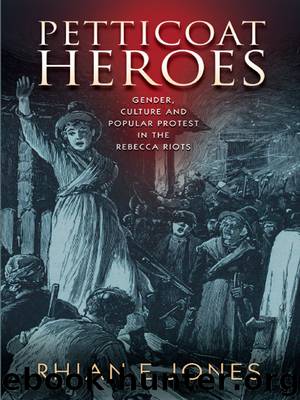Petticoat Heroes by Rhian E. Jones

Author:Rhian E. Jones
Language: eng
Format: epub
Publisher: University of Wales Press
7
‘Maid, spirit or man’:
Rebecca’s Image in Public Discourse
Chapter 5 examined the disjuncture between the feminine identities assumed by male Rebeccaites during protest, and the masculine descriptors employed for the same participants in press and court reports. This discussion established that protesters were seen as retaining a male identity which was not compromised by their temporary performance as Rebecca or one of her daughters. By contrast, contemporary representations of Rebecca in the press and other popular imagery tended to present her as an abstract female figure who could be shown in the guise of a host of social and cultural archetypes. Chapter 6 considered the changing image of female sexual agency in the 1830s and 1840s, and its relationship with images of Rebecca. This chapter will explore the wider array of identities which the figure of Rebecca assumed in the public imagination and political discourse, and how these identities, too, reflected or reinforced contemporary ideas about women.
The nature of womanhood was an ever-present topic of discussion in both working-class and middle-class society at the time of Rebecca. Debates on the moral character of women and the proper nature of women’s work permeated political, religious and scientific discourses as well as the fields of literary and visual representation.1 The presentation of Rebecca in the press as a stylised or allegorical figure also fits within wider currents of early nineteenthcentury politics, in which the female body was conspicuous in state and civic occasions. Women and girls were featured in national and local celebratory parades and ceremonies, including the coronation and opening of Parliament, dressed to represent allegorical virtues or symbolically to evoke purity and reproductive power. The female body, as Nicolas Rogers argues, ‘served as the symbol of the nation’s health and, indeed, in the figures of Britannia and Liberty, as the symbols of national unity, patriotism and independence’.2 Rogers and Epstein illustrate how the depiction of women as symbols in themselves, and as vehicles for symbolic display, could be co-opted by radical as well as loyalist pageantry.3 Popular politics at the time of Rebecca, then, granted the female body and female dress significance in political communication and mobilisation and in the occupation of public space. This significance combined the female body’s established associations of allegorical representation with the greater leniency afforded to women in public protest, which was based both on the presumption of their lower level of political awareness or engagement and on their capacity for irrational and unruly behaviour.4 All these tropes contributed to the popular conceptualisation of Rebecca.
The prominence of Rebecca’s image in the press indicates the contemporary importance of print culture in creating an enhanced sense of familiarity between leaders and led, through printed public addresses, portraits and cartoons. James Vernon’s exploration of the roles and personae adopted by nineteenth-century male political leaders, and projected onto them by their audiences and constituencies, finds that they ‘turned upon a relatively small number of familiar and popular narratives’.5 Analysis of the words and imagery used in press reports reveals that
Download
This site does not store any files on its server. We only index and link to content provided by other sites. Please contact the content providers to delete copyright contents if any and email us, we'll remove relevant links or contents immediately.
| Africa | Americas |
| Arctic & Antarctica | Asia |
| Australia & Oceania | Europe |
| Middle East | Russia |
| United States | World |
| Ancient Civilizations | Military |
| Historical Study & Educational Resources |
Life of Elizabeth I by Alison Weir(2027)
The Invisible Wall by Harry Bernstein(1768)
Art of Betrayal by Gordon Corera(1403)
1916 in 1966 by Mary E. Daly(1232)
Thunderstruck by Erik Larson(1191)
The Decline and Fall of the British Empire, 1781-1997 by Piers Brendon(1099)
A Brief History of Britain, 1066-1485 by Nicholas Vincent(1013)
A Brief History of Britain, 1485-1660 by Ronald Hutton(985)
Guy Burgess by Stewart Purvis(974)
Mary, Queen of Scots by Weir Alison(965)
Henry VIII by Alison Weir(914)
The Last Lion 02 - Winston Churchill - Alone, 1932-1940 by William Manchester(910)
Lang Lang by Lang Lang(838)
1066 by Andrew Bridgeford(832)
Gimson's Kings and Queens by Andrew Gimson(817)
The Last Plantagenet by Thomas B Costain(815)
Coalition by David Laws(811)
London: A Biography by Peter Ackroyd(804)
Diana by Andrew Morton(786)
